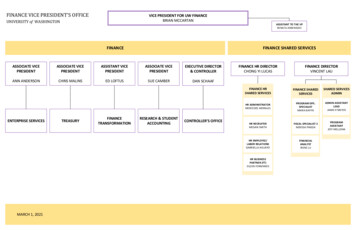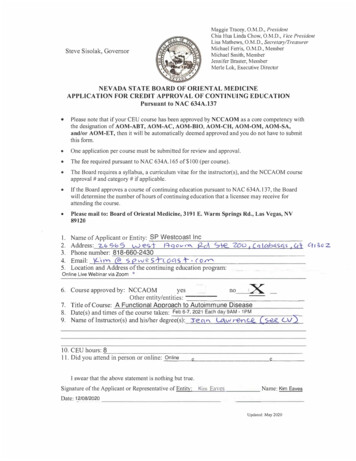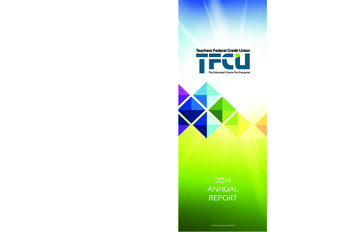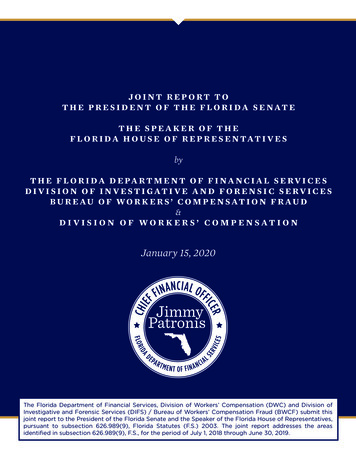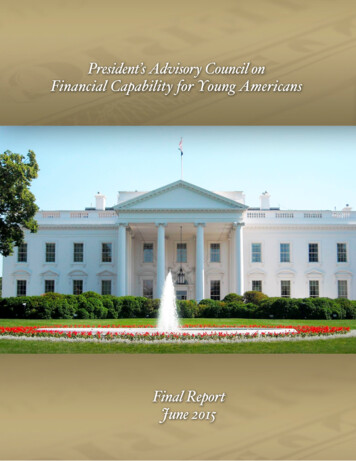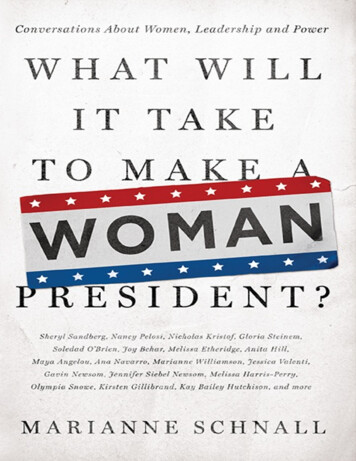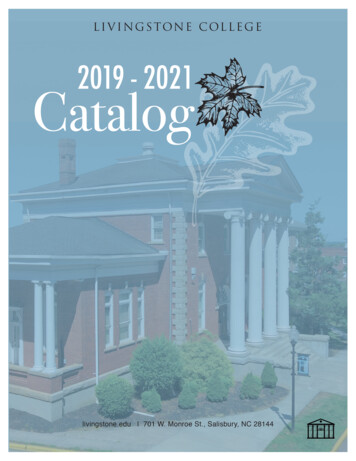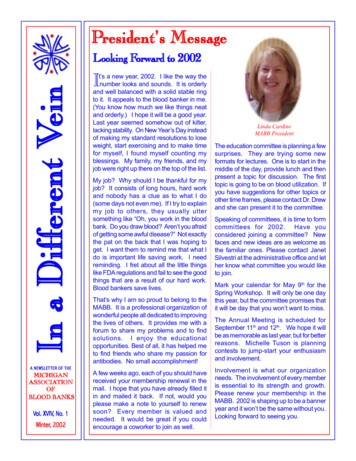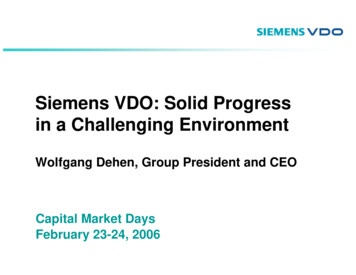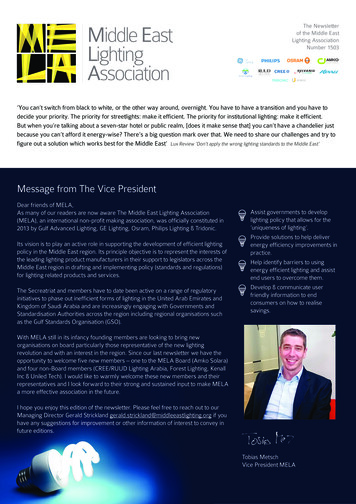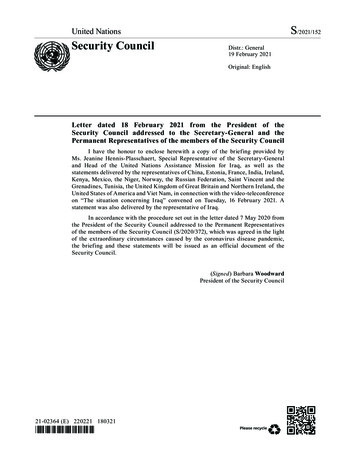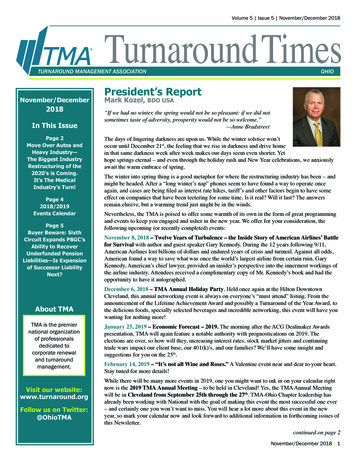
Transcription
Volume 5 Issue 5 November/December 2018Turnaround TimesTURNAROUND MANAGEMENT ASSOCIATIONNovember/December2018In This IssuePage 2Move Over Autos andHeavy Industry—The Biggest IndustryRestructuring of the2020’s is Coming.It’s The MedicalIndustry’s Turn!Page 42018/2019Events CalendarPage 5Buyer Beware: SixthCircuit Expands PBGC’sAbility to RecoverUnderfunded PensionLiabilities—Is Expansionof Successor LiabilityNext?About TMATMA is the premiernational organizationof professionalsdedicated tocorporate renewaland turnaroundmanagement.Visit our website:www.turnaround.orgFollow us on Twitter:@OhioTMAOHIOPresident’s ReportMark Kozel, BDO USA“If we had no winter, the spring would not be so pleasant: if we did notsometimes taste of adversity, prosperity would not be so welcome.”—Anne BradstreetThe days of lingering darkness are upon us. While the winter solstice won’toccur until December 21st, the feeling that we rise in darkness and drive homein that same darkness week after week makes our days seem even shorter. Yethope springs eternal – and even through the holiday rush and New Year celebrations, we anxiouslyawait the warm embrace of spring.The winter into spring thing is a good metaphor for where the restructuring industry has been – andmight be headed. After a “long winter’s nap” phones seem to have found a way to operate onceagain, and cases are being filed as interest rate hikes, tariff’s and other factors begin to have someeffect on companies that have been teetering for some time. Is it real? Will it last? The answersremain elusive, but a warming trend just might be in the winds.Nevertheless, the TMA is poised to offer some warmth of its own in the form of great programmingand events to keep you engaged and usher in the new year. We offer for your consideration, thefollowing upcoming (or recently completed) events:November 8, 2018 – Twelve Years of Turbulence – the Inside Story of American Airlines’ Battlefor Survival with author and guest speaker Gary Kennedy. During the 12 years following 9/11,American Airlines lost billions of dollars and endured years of crisis and turmoil. Against all odds,American found a way to save what was once the world’s largest airline from certain ruin. GaryKennedy, American’s chief lawyer, provided an insider’s perspective into the innermost workings ofthe airline industry. Attendees received a complimentary copy of Mr. Kennedy’s book and had theopportunity to have it autographed.December 6, 2018 – TMA Annual Holiday Party. Held once again at the Hilton DowntownCleveland, this annual networking event is always on everyone’s “must attend” listing. From theannouncement of the Lifetime Achievement Award and possibly a Turnaround of the Year Award, tothe delicious foods, specially selected beverages and incredible networking, this event will have youwanting for nothing more!January 25, 2019 – Economic Forecast – 2019. The morning after the ACG Dealmaker Awardspresentation, TMA will again feature a notable authority with prognostications on 2019. Theelections are over, so how will they, increasing interest rates, stock market jitters and continuingtrade wars impact our client base, our 401(k)’s, and our families? We’ll have some insight andsuggestions for you on the 25th.February 14, 2019 – “It’s not all Wine and Roses.” A Valentine event near and dear to your heart.Stay tuned for more details!While there will be many more events in 2019, one you might want to ink in on your calendar rightnow is the 2019 TMA Annual Meeting – to be held in Cleveland! Yes, the TMA Annual Meetingwill be in Cleveland from September 25th through the 27th. TMA-Ohio Chapter leadership hasalready been working with National with the goal of making this event the most successful one ever– and certainly one you won’t want to miss. You will hear a lot more about this event in the newyear, so mark your calendar now and look forward to additional information in forthcoming issues ofthis Newsletter.continued on page 2November/December 2018 1
Feature StoryPresident’s Report continuedOhio TMA OfficersPresidentMark KozelVice PresidentDan DeMarcoSecretaryMichael KaczkaTreasurerMark KutylowskiOhio TMABoard Members:Glenn BartleySally BartonKelly BurganMaria CarrThe end of 2018 represents a lot of things to each of us. Remembering successes and shortcomings,new friends gained and old ones lost, moments cherished and moments to be forgotten, resolutionsmade and resolutions to be made. While I share each of those, for me, it’s also a time of farewell asmy term as the president of the TMA Ohio Chapter comes to an end. On January 1st, Dan DeMarco,the chapter vice president, takes the reins of the presidency and applies his considerable talent tocontinuing to move the chapter forward. For that is the goal of each president of the chapter – tomove the organization forward, becoming more relevant in our industry and providing a forumwhere members and guests can learn, engage with one another, and make connections.If I have succeeded in any of that, it is attributable to the great team on the chapter’s Board thatworks so tirelessly to implement the programs, reach-out to new and old members, and keep TMAan important part of the restructuring community in Ohio. For that, I am most profoundly grateful.Dan will steer the ship in his own way, just as I steered the ship differently than Sally Barton whosteps down from her position as Past President at the end of the year. Sally passes that title downto me and assumed her Board position at National for another term. While we each differ in ourapproach, our goal is always the same – ensuring TMA membership provides value and relevancy tothe restructuring community. It’s been a privilege to work with Sally and Dan, and each and everymember of the Board. To be sure, I won’t be fading off into the sunset, but just taking on a smallerrole with the chapter.Finally, I will also be moving into “senior status” after the new year, as I move into retirementand work a bit less. It’s another change, to be sure, but one I look forward to. For each of you thathas worked side-by-side with me, taught me skills I never otherwise would have had, given meopportunities and trusted me, my sincere and heartfelt thanks.MarkThomas FurnasMary Jane HilkerMove Over Autos and Heavy Industry—Gus KallergisThe Biggest Industry Restructuring of the 2020’s is Coming.It’s The Medical Industry’s Turn!Suzana KochBy Dennis Kebrdle, Managing Partner, ChikolMichelle ManzolanSarah McIntoshMarc MerklinSteve SkutchRob StefancinRick SzekelyiChapter ExecutiveClaire StantonChapter ExecutiveEmeritus:Louise WalshIn a recent article, we made comments about the valuations and structures of buy/sell transactionshappening today, and were forced to ask ourselves, “Is it the 1980’s again?” Over the past few years,many in the turnaround/restructuring industry have likely been engaged in an increasing number ofprojects in the medical space. That includes: local & national labs, independent physician practices,stand-alone technology centers, medical staffing, high care and transitional nursing homes, homehealth care, medical equipment manufacturers & the suppliers to these players and hospitals. As thevolume of transactions and restructuring in the medical space has increased over the past few years,it seems time to look back to see what could be driving the increased volume in this space.As usual, the increase in activity is because that is where the money is and everyone is trying tofigure out how to get a taste of that wave. The entry of many private equity and investment firmsinto the medical space resulted from a number of factors, including investors looking to cash out toprivate owners looking for their next steps. With regional and national roll-ups going on, and withtons of money chasing the cashflow, it is a great time to be a buyer or perhaps a seller.It’s no secret that medical spending is on the rise nationally. The 933.5 billion increase in healthcarespending from 1993 to 2013 has been driven by a number of factors1: The increase in population during this timeframe accounted for a 23.1% increase in spending, or 269.5 billion Aging accounted for an 11.6% increase, or 135.7 billion Pricing and intensity of treatment drove a 50% increase in spending, or 583.5 billion2 Turnaround Times[1] Dieleman, J.L., Squires, E., Bui, A.L., et al. Factors associated with increases in US health care spending, 1996-2013.(2017, November 7)
Disease actually accounted for a decrease in spending of 2.4%, or 28.2 billionNationally, Baby Boomers are aging and needing more care. People over 65 years of age experiencethree times more hospital stays than the general public, while those over 75 years of age havefour times as many hospital stays. These simple demographic facts create a huge opportunity fordoctors, hospitals, labs and caregivers in general to deal with demand beyond anything experiencedpreviously.Adding to that situation, payments for healthcare are, for the most part, covered by eithergovernment or insurance, meaning investors can easily see strong sustained cash flow to rely onwhen paying huge multiples. What we find surprising when looking at deals in this space is to bediscussing multiples of SALES and not EBITDA at huge valuations—sometimes double the normalindustry rates when the operation being pursued is running at or above industry performance levels.When we began in the early 1980s, we did our first leveraged transactions. Most were in themanufacturing or retail spaces, and that continued throughout the 1990s. The prices being paid thenreflected the “value & cost” of funds being used in the marketplace, with 3-5X EBITDA being thenorm. That isn’t anywhere near where transactions in the medical space are today—but the valuationdynamics are so similar it is DEJA-VU!In our experience, buyers in this space have been paying tremendous multiples of EBITDA,often 10-20X, and in many cases, where volume is a driver, even 1.5-3X sales! With these kindsof multiples, it is certainly the time to be active in the medical space, by understanding what theincremental purchased volume will bring to a “core company” in order to justify these huge pricesand competitive situations. Restructuring professionals most certainly have a role to play by helpingdrive earnings and reducing this industry’s widespread and significant profit leakage!Looking back and then reflecting on today’s marketplace, we are finding similarities to the evolutionthat has overtaken the auto industry. The increased use of medical services by both boomers andeven the younger generations are forcing the medical industry to innovate and change just as it didthe auto industry. This increased volume has put a strain on the system, stimulating ways to growcapacity, manage personnel shortages and innovate—by an industry that has never had to closelymanage transactional costs or inventory dynamics.As you may recall, the auto industry evolution really went to the next level in the 80s, when theJapanese entered the market with lower costs and better production approaches. The Big 3 hadn’tworried about anything but making sure there were sufficient cars on lots to meet the demand. Salesand profit were sure to follow, they believed, with prices rising as needed to ensure their targetedresults. It worked until the Japanese arrived with lower prices, standard features and consistentquality--all driven by a lower average cost of production brought about through improved equipmentand a reduction in the capital, primarily inventory, that was needed for each car sold.We all remember how the restructuring of the auto industry impacted the entire supply base, andthe current supply chain model in most of manufacturing reflects that evolution. Not only did theindustry change and streamline, but every newly-christened “just in time” supplier down the channelhad to adopt “lean” and “quality” as the new way of life or die! Not only did the production costmatter, but with the cost of funds in double digits, the capital needed for every part in inventorydrove them to change how every production plan was formalized.continued on page 4Featured SponsorOhio TMACorporate SponsorsPLATINUMBaker & Hostetler LLPBDO USA LLPBrouse McDowellCalfee Halter& Griswold LLPCentrus GroupChikol Equities, Inc.Inglewood AssociatesLLCMcDonald HopkinsLLCPhoenix ManagementServicesThe Skutch ArlowGroup LLCSILVERCrestmark BankMorrisAndersonPresidential FinancialCorp.Ritchie Bros.Siena Lending GroupThompson Hine LLPWalter HaverfieldChikol specializes in working with small to medium-sized companiesthat need assistance in developing strong leadership and the experiencerequired to deal with issues created by the current economic conditionsor internal issues preventing the company from performing to its highest level. It was foundedin 1990 after the managing partners combined their more than 30 years of experience as owneroperators and with purchasing companies in financial distress. Chikol’s top priority is valueenhancement and operational improvement.November/December 2018 3
Feature Story continuedIn our view, the medical space appears to be on the verge of thatsame industry evolution. The demand for increased services in anindustry with a critical shortage of workers means doing businessthe same way it’s always been done will no longer work. This rapidgrowth and increase in spending is priming the search for costsavings and productivity improvement.Providers are embracing tele-med and other technologies hithertoshunned in order to help meet these challenges. PA’s and NP’sare becoming more prominent as they take some of the workloadoff physicians to improve the efficiency of providing healthcare.Medical innovation hubs are becoming the norm rather than anovelty. Tie this situation to the rapid increase in the cost of funds(25-35% in the last year) and it feels just like the auto industry allover again!With the government teaming with the insurance industry throughthe implementation of the Affordable Care Act, both are startingto search for price compression with volume. At the same time,individuals are being asked to pay the highest deductibles inhistory. According to recent data from the Centers for Medicare andMedicaid Services (CMS), the average American spent 9,596 onhealthcare in 2012 compared to 7,700 in 2007. In 2016 the averageannual cost per person hit 10,345, while in 1960 the averageannual cost per person was 146. In this instance, the forces ofconsumer, provider and payer are all united in trying to address theincreasing cost of healthcare and what can be done to stem that tide.Much more “leakage” exists in medical space engagements thanwe have seen in manufacturing and service industry projects.We’re reminded of 30 years ago, when companies tracked the priceof steel, but the shipping, rework, overtime and packaging wereviewed as “small money” --“immaterial” – “rounding” and notwatched very much at all. For those of us who came from “pennybusiness” backgrounds like the grocery industry, life was all aboutsingle bites, and we attacked those small areas vigorously.In virtually every medical project we’ve had lately, the CFO hascommented that many of our initiatives were “immaterial” and“not worth our valuable time” to worry about. But as we all know,every penny that can be saved is valuable and ends up in mostengagements helping management to get incremental margins wheremost thought it wasn’t worth it. In one notable situation, whererevenues were about 80 million, we were able to recapture 6.5million in savings in the “immaterial” areas that we had identified.Although the medical industry is experiencing some of thechallenges we all saw in the ‘80’s, the size of the industry, alongwith its dramatic growth, will bring prospective buyers plenty ofopportunities as long as they make sure they gain control of thetrain. We all need good healthcare and often times we can’t put it offlike we sometimes do when buying a new car!But for those of us in the operational improvement & turnaroundbusiness, there will be abundant opportunities to again assist ourinvestor, lender and owner friends who are in, or considering theexploding medical marketplace. If not, they will likely be run overin the next few years, and with the prices being paid—it will beugly. If we add in the growing cost of funds, the time for attention isnow, not tomorrow!!And as we seasoned professionals know, “we’ve been there—wecan help!”2018/2019 EVENTS CALENDARDecember 6, 2018TMA Annual Holiday Party. Hilton Downtown Cleveland. Includes announcementof the Lifetime Achievement Award andpossibly a Turnaround of the Year Award.2019 ProgramsJanuary 25Economic Speaker. Breakfast meetingfollowing ACG Deal Maker’s eventFebruary 14Not all Wine and RosesMarch 20NCAA Pre-EventApril 25Tariffs and their impact on businessSeptember 25-27TMA Annual Meeting in ClevelandMay 23-24TMA Great Lakes Conference, Avalon InnOctober 24TMA/CMBA Education event*June 11November 19TMA/ACG Summer Event at Shoreby Club Improving productivity in medicine*July 15TMA Golf Classic at Mayfield CountryClubAugust 29Annual TMA/CFA Shuffleboard EventDecember 12Holiday EventPlease note: * These two events mightswitch depending on timing coordinationwith CMBAGeneral note: The dates and subjects listed on this proposed 2019 event calendar are subject to change to accommodate: speakers andvenue availability, verification by other organizations in the case of joint events, and current events that might pre-empt the initial schedule. As always, each program announcement will have the definitive word on the specifics of each event.4 Turnaround Times
Buyer Beware: Sixth Circuit Expands PBGC’s Ability to Recover UnderfundedPension Liabilities—Is Expansion of Successor Liability Next?By Michael J. Kaczka and Maria G. Carr, McDonald HopkinsSingle-employer pension plans are less commonplace these days,but remain a reality for many companies to deal with large, accruedbalances from pensions implemented decades earlier. If a companyis already financially unstable, the prospect of paying for these pension liabilities for years to can drive a company toward insolvencyor possible bankruptcy.plan terminates without enough funds to satisfy its obligations, andwithdrawal liability, which attaches when one employer in a multiemployer pension plan leaves the group. ERISA further providesthat the sponsor of a terminated plan (typically, the employer) andany “trades or businesses” related to the sponsor through ties ofcommon ownership are also jointly and severally responsible forliabilities of underfunded pensions. This is known as “commoncontrol liability.”Affiliates and successors of financially troubled businesses are alsoat risk for these unpaid pension obligations. As detailed in a SixthCircuit opinion issued earlier this fall, creative asset restructuringWhen Findlay became insolvent in 2009, it had 18 million inefforts and long-term financial planning may not be enough for affil- underfunded pension liabilities (an amount that is now arguably iniates or successors to escape legacy pension liabilities.excess of 30 million when fines and interest are included). Facing aseries of difficult options, Findlay eventually arranged an asset saleThe issues raised in the appeal of the case, Pension Benefit Guarwhereby Findlay’s equipment, inventory and receivables from twoanty Corporation v. Findlay Industries, Inc. (902 F.3d 597, 6th Cir.of Findlay’s plants were sold to a company called F.I. Asset Acquisi2018) involved two sets of parties related to the business failuretion, for a price of 2.2 million in cash and 1.2 million in assumedof Findlay Industries, the plan sponsor under a single-employerpension plan. Those parties were a trust that obtained property from trade debt – excluding pension liabilities.Findlay’s founder but then leased it right back to Findlay and thecompanies that
TMA is the premier national organization of professionals dedicated to corporate renewal and turnaround . stand-alone technology centers, medical staffing, high care and transitional nursing homes, home health care, medical equipment manufacturers & the suppliers to these players and hospitals. .
